This is the final installment a nine piece installment ranking the Indians top prospects. All photos in this installment are courtesy of Carl Kline. To get in touch with Carl Kline for photo assistance, please e-mail me at tlastoria@theclevelandfan.com and I will forward his e-mail address to you.
One note, these height and weights are as of Feb/March 2007 as new height and weights are not available yet, so players have gotten bigger over the last year than the listed vitals. Also, all ages are as of 04/01/2008.
5. Chuck Lofgren - Left-handed Pitcher
Age: 22 Height: 6'4" Weight: 215 Bats: Left Throws: Left
| | W | L | ERA | G | GS | SV | IP | H | ER | HR | BB | K | BB9 | K9 | WHIP |
| 2007 Akron/Buffalo | 12 | 8 | 4.58 | 26 | 26 | 0 | 151.3 | 160 | 77 | 15 | 71 | 130 | 4.22 | 7.73 | 1.53 |
| Career | 34 | 18 | 3.48 | 79 | 79 | 0 | 406.3 | 365 | 157 | 30 | 181 | 367 | 4.01 | 8.13 | 1.34 |
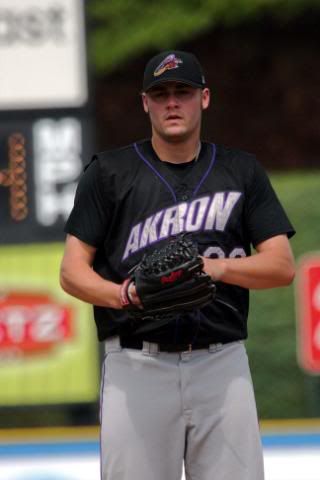 History: Lofgren was projected to go much higher in the 2004 Draft, but fell due to signability concerns, and the Indians eventually selected him in the 4th round out of Junipero Serra High School (CA). He graduated from the same high school as Barry Bonds, Tom Brady, Lynn Swann and Greg Jeffries. Lofgren's 2006 season at Kinston was sensational, as he went 17-5 with a 2.32 ERA, held opponents to a .217 batting average against (BAA), and piled up 125 strikeouts in 139.2 IP. Lofgren set a Kinston modern-day franchise record for victories by a pitcher in a season with 17, and his 17 wins tied him for the most wins in all of the minors that season. He was also named the Carolina League Pitcher of the Year. In a May start on Mother's Day last year, Lofgren threw seven no-hit innings before leaving because of a high pitch count.
History: Lofgren was projected to go much higher in the 2004 Draft, but fell due to signability concerns, and the Indians eventually selected him in the 4th round out of Junipero Serra High School (CA). He graduated from the same high school as Barry Bonds, Tom Brady, Lynn Swann and Greg Jeffries. Lofgren's 2006 season at Kinston was sensational, as he went 17-5 with a 2.32 ERA, held opponents to a .217 batting average against (BAA), and piled up 125 strikeouts in 139.2 IP. Lofgren set a Kinston modern-day franchise record for victories by a pitcher in a season with 17, and his 17 wins tied him for the most wins in all of the minors that season. He was also named the Carolina League Pitcher of the Year. In a May start on Mother's Day last year, Lofgren threw seven no-hit innings before leaving because of a high pitch count.
Strengths & Opportunities: Lofgren is as legit as it gets, and is one of the top ten left-handed pitching prospects in all the minors. Lofgren is a physical starting pitcher who has a good four-pitch mix led by a fastball that ranges from 90-93 MPH but tops out at 95 MPH. In addition to the fastball, Lofgren also throws a slow curveball that tops out at around 75 MPH and a changeup and slider which sit in the low 80s. He possesses the best swing-and-miss fastball statistic in the system, and that swing-and-miss rate is heavily influenced by Lofgren's good fastball command, velocity and deception in his delivery.
As a young pitcher pitching at an advanced level last season, Lofgren displayed great mound presence and his combination of athleticism and power on the mound is exciting. Lofgren is a competitor on the mound, and likes to attack hitters on the inside part of the plate with his fastball. He is very good at changing speeds and mixing his pitches. Because of the varying speeds and repertoire, it gives him many weapons to attack hitters and keeps them from zeroing in on one pitch, speed and location.
Several comparisons have been made of Lofgren to a young Al Leiter as his stuff, presence and approach are nearly identical. Lofgren also has a knack for kicking it into a second gear on the mound when he has to pitch with runners in scoring position. Pressure just does not phase him, and he is comfortable on the mound in any situation. The Indians have been most impressed with Lofgren's consistency from start to start, and feel this is a direct result of Lofgren's commitment to routine and being very mature for his age. He is a student of the game in that he understands and appreciates the history of the game. He also is grounded ego-wise where he understands he is in a special place and that he is talented and is going to make the most of it.
Lofgren came into the system with basically a fastball/curveball mix, and while his curveball was his out pitch in high school, at times he leaves it up and it is not nearly as good as it was when he was an amateur. Lofgren has sharpened his curveball up over the past two seasons and the results started showing in his sensational 2006 season. Lofgren still needs some refinement with his delivery, and he needs to work on being more efficient with his pitches since his pitch counts get high by the middle innings of games. While he has good fastball command, in order for him to pitch and have success in the big leagues Lofgren still has to command his fastball better than what he has shown so far. Also, he needs to work more on finishing off hitters. His changeup is the biggest key for him and he still needs more work on developing it.
Lofgren had mixed results last year at Akron, but he adapted well to Double-A at a young age. It should be noted that it took half a season for Adam Miller to catch fire and dominate in 2006, as the jump from Single-A to Double-A is arguably the biggest step in the minors. While he did not match his outstanding statistical season from 2006 when he won 17 games and had a sub-3.00 ERA, there was no way he could duplicate it and anything he did was not going to be viewed as good as that year.
Outlook: The organization is enthusiastic and very excited about Lofgren's potential. Lofgren's aptitude is off the charts, which is why he continues to move through the Indians system quickly. Lofgren is on the fast-track to the major leagues, and could debut as a September callup this season before he gets strong consideration for a spot on the major league roster in spring training of 2009. This year, Lofgren should move up and be part of a talented and deep starting rotation in Buffalo.
Video: Lofgren on the mound in spring training.
4. Jensen Lewis - Right-handed Pitcher
Age: 23 Height: 6'3" Weight: 195 Bats: Right Throws: Right
| | W | L | ERA | G | GS | SV | IP | H | ER | HR | BB | K | BB9 | K9 | WHIP |
| 2007 Akr/Buf/Cle | 4 | 1 | 1.88 | 60 | 0 | 2 | 81.3 | 58 | 17 | 4 | 27 | 95 | 2.99 | 10.52 | 1.05 |
| Career | 15 | 10 | 3.34 | 75 | 38 | 2 | 258.7 | 241 | 96 | 24 | 69 | 258 | 2.40 | 8.98 | 1.20 |
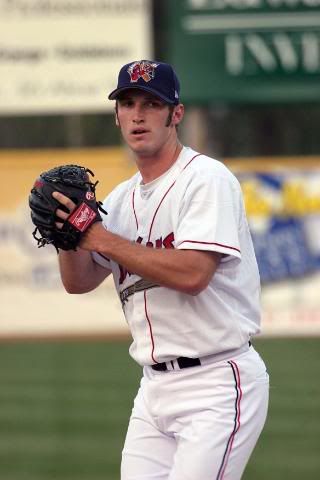 History: Lewis was picked in the 3rd round of the 2005 Draft out of Vanderbilt University. Lewis was a mid-season NY-Penn League All Star in 2005 while at short-season Single-A Mahoning Valley, and in 13 appearances (11 starts) Lewis was 4-2 with a 3.20 ERA and in 59 innings pitched allowed 58 hits, 11 walks and struck out 59. Still a starter in 2006, Lewis went 8-8 with a 3.96 ERA in 27 combined starts in Kinston and Akron. As a reliever last year, when he was promoted from Akron to Buffalo he gave up a solo home run to the first batter he faced and after that only allowed one run. From May 1st until he was called up to Cleveland on July 13th he had a 0.68 ERA.
History: Lewis was picked in the 3rd round of the 2005 Draft out of Vanderbilt University. Lewis was a mid-season NY-Penn League All Star in 2005 while at short-season Single-A Mahoning Valley, and in 13 appearances (11 starts) Lewis was 4-2 with a 3.20 ERA and in 59 innings pitched allowed 58 hits, 11 walks and struck out 59. Still a starter in 2006, Lewis went 8-8 with a 3.96 ERA in 27 combined starts in Kinston and Akron. As a reliever last year, when he was promoted from Akron to Buffalo he gave up a solo home run to the first batter he faced and after that only allowed one run. From May 1st until he was called up to Cleveland on July 13th he had a 0.68 ERA.
Strengths & Opportunities: While Lewis consistently threw 90-92 MPH as a starter, the Indians felt he could add more velocity as he matured and was shifted to the bullpen, which is exactly what happened. The Indians moved Lewis into a bullpen role at the start of last season, and Lewis immediately impressed and quickly moved into the Indians bullpen picture by midseason. Lewis was moved up to Cleveland on July 13th and he became a vital piece to the bullpen through the rest of the season and in the playoffs. The shift to the bullpen allowed Lewis to be much more aggressive and throw harder. His fastball velocity increased to where he was consistently throwing 93-94 MPH, and his strikeout ratios increased dramatically (8.41 K/9 in 2006 to 10.56 K/9 in 2007) and his WHIP decreased considerably (1.30 in 2006 to 0.94 in 2007).
Lewis is aggressive with his fastball and can elevate it, while his changeup is above average and is a devastating out pitch to both right-handed and left-handed hitters. He also has just developed a little cut slider that he can throw with two strikes and in on a lefty to get a groundball, and it really is two different pitches depending on if he is facing a left-hander or right-hander. The addition of his newly developed slider was the pitch that finished him off to make him a quality reliever.
Lewis handled the bullpen transition well, which goes back to his experience pitching out of the bullpen at Vanderbilt. Going into last season, the Indians thought Lewis was a guy who could come quick in the bullpen because he is a hyper guy and gets loose quick. Also, there was really not a lot of development left for him, so there was not a big need to keep him in the starting rotation to continue to work on his pitches, game situations and his mechanics in five to six innings an outing and in bullpen sessions between starts. The Indians saw Lewis as a guy who could probably be better facing a lineup once than flipping around through it three times. Over the course of the season, Lewis showed a great ability to bounce back to the daily grind in the bullpen.
One of the big reasons for his success is his makeup on the mound and the confidence that flows from him while on it. Lewis has a very strong mental approach to the game, and has excellent command. He is fundamentally sound, controls the running game, and fields his position well. He is very athletic, and he creates good deception with his delivery. He is one of the most disciplined players in the Indians organization, and highly intelligent. He has really made the most of his development opportunities, and everything he has been asked to do he has answered the call.
Outlook: Along with Aaron Laffey, Lewis was the hottest pitcher in the system last year. One of the Indians biggest problems since their rebuild has been their inability to develop quality relievers, and with Rafael Perez and Lewis last year along with a laundry list of good relief candidates currently in the minors, it appears their fortune has changed for the better. Lewis will go into the season as one of the Indians primary bullpen options and pitch in the 7th and 8th inning. Down the road, he could become the team's main setup main or even the closer.
3. Wes Hodges - Third Baseman
Age: 23 Height: 6'2" Weight: 180 Bats: Right Throws: Right
| | AVG | G | AB | R | H | 2B | 3B | HR | RBI | BB | K | SB | OBP | SLG | OPS |
| 2007 Kinston | .288 | 104 | 393 | 60 | 113 | 22 | 3 | 15 | 71 | 44 | 90 | 0 | .367 | .473 | .840 |
| Career | .288 | 104 | 393 | 60 | 113 | 22 | 3 | 15 | 71 | 44 | 90 | 0 | .367 | .473 | .840 |
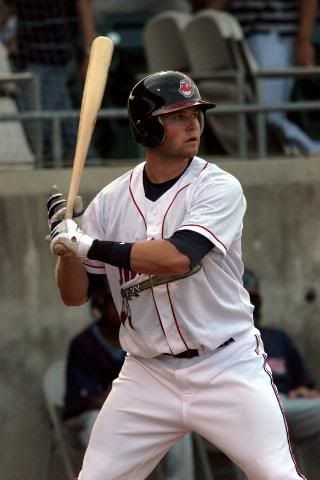 History: Hodges was drafted in the 2nd round of the 2006 Draft out of Georgia Tech, but did not play in 2006 with the Indians since he was still mending from a stress fracture in his foot. Even though he basically played on one leg more almost all of his final season at Georgia Tech, Hodges still hit .329 with 11 HR and 68 RBI in 219 at bats. Last year, Baseball America tabbed Hodges as the best power prospect, the best defensive third baseman, and having the best tools in the Carolina League. He was also named Team MVP at Kinston, and was a Carolina League Post-Season All Star.
History: Hodges was drafted in the 2nd round of the 2006 Draft out of Georgia Tech, but did not play in 2006 with the Indians since he was still mending from a stress fracture in his foot. Even though he basically played on one leg more almost all of his final season at Georgia Tech, Hodges still hit .329 with 11 HR and 68 RBI in 219 at bats. Last year, Baseball America tabbed Hodges as the best power prospect, the best defensive third baseman, and having the best tools in the Carolina League. He was also named Team MVP at Kinston, and was a Carolina League Post-Season All Star.
Strengths & Opportunities: Hodges is a player who was born to hit. When he broke the hamate bone in his left wrist his senior year in high school, instead of missing the year he taught himself to hit from the left-side of the plate and hit .430 that year. Hodges is a very disciplined hitter with great bat-to-ball ability, and has a nice line drive stroke with good power potential to all fields. Hodges handles fastballs well, although he has to go through the growing period with learning to recognize and hit changeups and breaking balls and making adjustments. He should be able to as his aptitude is off the charts and he has an unbelievable ability to make adjustments.
As a defender, Hodges does it all with good hands, a strong arm and very good range at third base. The Indians like his athleticism at third base, and combined with his very advanced and professional bat feel he is a rare find. He was okay last year at third base, but the feeling by those in the game is he can become even better and the arm is good enough to handle the position. It is just a matter of getting a little experience. The Indians are in no rush to push him, and feel he is one of the most intelligent baseball players in the system and a true student of the game.
Hodges has the potential to be the biggest impact player from the Indians 2006 Draft, and would have been taken higher in the draft if he did not have some injury concerns. Going into 2006, Hodges was ranked as a preseason Top 10 college draft prospect and surefire first round pick, but that ranking took a hit when he came down with a stress fracture in his left leg. Hodges fell on draft day, and the Indians gambled and selected Hodges with their third of four second round picks. The Indians signed him for $1 million and to a 2007 contract to hold him out of action the rest of the season and give him more time to mend from the injury. Hodges came back from the injury well, but he was sidelined with two other injuries the first half of last season with a bad hamstring and broken toe in his left foot that saw him miss just short of a month of action. Hodges played the last half of the year with a sore foot as the broken toe did not require surgery and could heal on its own, but was bothersome while it healed. It remains to be seen if the injury issues he has had the last two years is a chronic issue to be concerned about.
Hodges hamstring injury and broken toe injuries last year may have been a blessing in disguise. While out with the injury, it gave Hodges time to step back, take a deep breath, and make some early adjustments since it was his first professional season. It gave him extra time to work with Kinston hitting coach John Nunnally on shortening his swing and simplifying his approach at the plate. Early in the year, Hodges swing mechanics were somewhat erratic as he held his hands close to his chest and as the pitcher went into his delivery he would slide them back to generate load in his bat. This hitting style gave Hodges fits against pitchers with quick deliveries and slide steps from the stretch. Nunnally did some tinkering where he cocked Hodges hands back into a pre-loaded position by his right shoulder and use his legs as a timing mechanism and to shift load in his bat. Hodges became more relaxed at the plate and began to look for certain pitches early in the count.
There was talk last year of moving Hodges up to Akron around the Carolina League All Star break in late-June, but the Indians decided against it as they did not want to rush Hodges and still felt there were some things he could better work on in Kinston with hitting coach John Nunnally. While Hodges work ethic is second to none, he is still adapting to the everyday grind of professional baseball and learning to be more consistent. Going forward, Hodges needs to continue applying his relaxed, patient approach to the plate as he had a real hard time jumping after off-speed pitches too soon last year. He also needs to continue applying what Nunnally taught him in thinking down and through the ball to help create more line drives. This past fall, the Indians worked on getting Hodges legs more into his swing and his first step quickness on defense. He also needs to get stronger.
Outlook: With Kevin Kouzmanoff being sent packing to San Diego in the Josh Barfield trade last offseason, and Andy Marte struggling to stay in Cleveland, Hodges is the top third base prospect in the system. If he can stay healthy and on the field he will move through the system quickly, and is someone who could push for a major league job sometime in 2009. There is no one above him at Buffalo blocking him, so if he impresses the first half of the season at Akron he could move to Buffalo by mid-season and possibly even be a September callup for the Indians. Hodges will start the year at Akron.
Video: Hodges at the plate.
2. Jordan Brown - First Baseman
Age: 24 Height: 6'0" Weight: 205 Bats: Left Throws: Left
| | AVG | G | AB | R | H | 2B | 3B | HR | RBI | BB | K | SB | OBP | SLG | OPS |
| 2007 Akron | .333 | 127 | 483 | 85 | 161 | 36 | 2 | 11 | 76 | 63 | 56 | 11 | .421 | .484 | .906 |
| Career | .307 | 271 | 1031 | 171 | 317 | 63 | 10 | 29 | 171 | 117 | 122 | 17 | .385 | .472 | .858 |
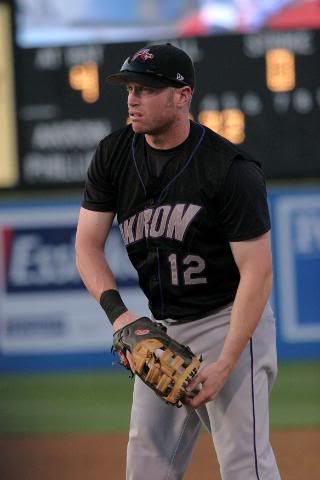 History: Before last season, Brown got a lot less pub than his former University of Arizona Wildcat teammate Trevor Crowe. While Crowe was drafted in the 1st round of the 2005 Draft, Brown was selected a few rounds later in the 4th round of the same draft. After a very slow start in 2006 where he hit .232 with 0 HR and 9 RBI in Kinston's first 28 games that season, Brown settled in to finish the season hitting .290 with 15 HR, 87 RBI and an .831 OPS and won the Carolina League MVP Award in 2006, and his career has taken off from there. Last year at Akron, his .333 batting average won him a league batting title, and he also finished 1st in the league in hits (161), 6th in runs (85), 4th in doubles (36), 9th in RBI (76), 3rd in on-base percentage (.421), 11th in slugging percentage (.484), and 5th in OPS (.906).
History: Before last season, Brown got a lot less pub than his former University of Arizona Wildcat teammate Trevor Crowe. While Crowe was drafted in the 1st round of the 2005 Draft, Brown was selected a few rounds later in the 4th round of the same draft. After a very slow start in 2006 where he hit .232 with 0 HR and 9 RBI in Kinston's first 28 games that season, Brown settled in to finish the season hitting .290 with 15 HR, 87 RBI and an .831 OPS and won the Carolina League MVP Award in 2006, and his career has taken off from there. Last year at Akron, his .333 batting average won him a league batting title, and he also finished 1st in the league in hits (161), 6th in runs (85), 4th in doubles (36), 9th in RBI (76), 3rd in on-base percentage (.421), 11th in slugging percentage (.484), and 5th in OPS (.906).
Strengths & Opportunities: Brown has an amazing ability to put up consistent numbers from month to month and year to year. He is a very disciplined hitter and gets on-base at a very good clip. He is one of the best players in the system at bat-to-ball ability and making hard, consistent contact as demonstrated by his low strikeout totals where he strikes out only once every 8.5 at bats for his career and has virtually a 1:1 walk to strikeout ratio for his career. Brown will likely at most be a 20-25 HR a year hitter, but he has good gap power and piles up doubles. Baseball America rated Brown as having the best tools, best strike zone judgment, and as the best batting prospects in the Eastern League last year.
Brown is a pure hitter with incredible hand-eye coordination and a passion for hitting. His sweet swing and approach at the plate has drawn many comparisons to the likes of Sean Casey, Mark Grace and John Olerud, players who never hit for a lot of power but hit for a high average and piled up doubles. Brown is athletic and a hard worker. While he only has average speed, his intelligence as a runner helps him get good jumps to steal bases and take extra bases on hits.
Given the depth the Indians farm system had in the outfield going into last season, Brown was moved back to first base last year. Brown has played first base and outfield throughout his college and professional career, and the flexibility to adequately play both positions will help him down the road as he looks to make the big league club. With such a logjam in the outfield and at first base at Buffalo this year, Brown may end up splitting his time at both first base and outfield. He moves well around the bag, but he still needs more work on his overall defense and positioning with relay throws from the outfield.
Brown's consistent and very good season is even more impressive when you consider he was bothered by an injury to his left knee since May, and the injury lingered all year as he played through it. Brown had scar tissue and bone chips in his knee causing pain, but he was informed he could not injure himself any worse by playing, so he opted to play through the season and have arthroscopic surgery in the offseason. The only thing the injury really affected was Brown's ability to run the bases as it slowed him down some. Brown's only other injury since joining the Indians was a hand injury he suffered in 2005 which limited him to only 19 games at Mahoning Valley after being drafted.
Last year, Brown was named the Eastern League Rookie of the Year, which is an award that has good company. Since the award came into existence in 1996, Eastern League Rookie of the Year honorees have included Vladimir Guerrero (1996), Mark Kotsay (1997), Pat Burrell (1999), Alex Escobar (2001), Marlon Byrd (2002), Grady Sizemore (2003), and Ryan Howard (2004). He also was named MVP of the Eastern League, which was Brown's second straight MVP-season as he won the Carolina League MVP Award in 2006. Brown's back-to-back MVP seasons are only rivaled by Victor Martinez, as he won the Carolina League MVP in 2001 and the Eastern League MVP in 2002 in successive years just like Brown. Brown was also the Topps Carolina League Player of the Year in 2006 and Topps Eastern League Player of the Year in 2007.
Brown came in as a hacker when he was drafted, but has learned to understand the value of getting good pitches to hit. He understands that he can not do damage early in the count with marginal pitches, and he has developed into one of the best strike zone managers in baseball. Going forward, there is not a lot he needs to do as a hitter as he really just needs to continue learning to make adjustments and get some at bats in Triple-A. His main focus will be on improving defensively, be it at first base or in the outfield. If he hones his defensive skills, he could be a very special player for a long time.
Outlook: Even after winning the Carolina League MVP in 2006 at Kinston, Brown still seemed to come into the 2007 season somewhat under the radar. Not anymore. Brown quickly proved last year that his MVP season was legit, and that he was a prospect to be reckoned with. Brown just needs a little seasoning in Triple-A, and is an option for the Indians really anytime in 2008. He will start the year in Buffalo.
Video: Brown at the plate and taking batting practice in spring training.
1. Adam Miller - Right-handed Pitcher
Age: 23 Height: 6'4" Weight: 200 Bats: Right Throws: Right
| | W | L | ERA | G | GS | SV | IP | H | ER | HR | BB | K | BB9 | K9 | WHIP |
| 2007 Buffalo | 5 | 4 | 4.82 | 19 | 11 | 0 | 65.3 | 68 | 35 | 4 | 21 | 68 | 2.89 | 9.37 | 1.36 |
| Career | 32 | 24 | 3.61 | 98 | 88 | 0 | 461 | 431 | 185 | 28 | 137 | 455 | 2.67 | 8.88 | 1.23 |
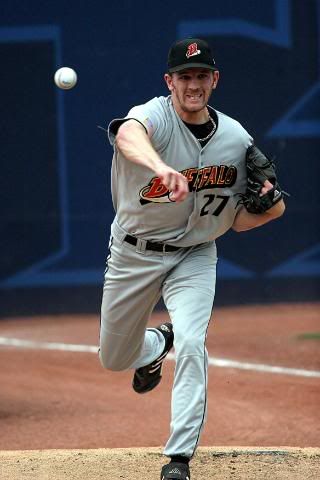 History: Miller was drafted out of high school (TX) in the 1st round of the 2003 Draft, and had a commitment to play for the University of Arizona before signing with the Indians. Miller was unbelievable the final two months of the 2006 season at Akron as he posted a 0.29 ERA in July and a 1.59 ERA in August, and then followed that up in spring training last year by pitching 14 scoreless innings in five games. Miller's 15 wins at Akron in 2006 set a franchise record, passing Paul Byrd's 1992 franchise record of 14 wins in a season. His 161 strikeouts also crushed the single-season team record of 149, which was set by Travis Driskill in 1996. He was named the Eastern League Pitcher of the Year in 2006, and was also the Indians Minor League Pitcher of the Year (Bob Feller Award) in 2004 and 2006.
History: Miller was drafted out of high school (TX) in the 1st round of the 2003 Draft, and had a commitment to play for the University of Arizona before signing with the Indians. Miller was unbelievable the final two months of the 2006 season at Akron as he posted a 0.29 ERA in July and a 1.59 ERA in August, and then followed that up in spring training last year by pitching 14 scoreless innings in five games. Miller's 15 wins at Akron in 2006 set a franchise record, passing Paul Byrd's 1992 franchise record of 14 wins in a season. His 161 strikeouts also crushed the single-season team record of 149, which was set by Travis Driskill in 1996. He was named the Eastern League Pitcher of the Year in 2006, and was also the Indians Minor League Pitcher of the Year (Bob Feller Award) in 2004 and 2006.
Strengths & Opportunities: Miller is an extremely confident pitcher, and aggressively attacks every hitter. His four-seam plus-plus fastball consistently clocks in at around 96-97 MPH and it has topped out as high as 101 MPH, and he also throws a two-seam fastball that bottoms out well and allows him to better change speeds on his fastball. His best pitch is his plus-plus devastating power slider that he throws in the upper 80s that has excellent tilt and shows great late break. He also throws a changeup, which has become a very good weapon for him and shows good depth. When he is on with the pitch, the development of Miller's changeup has made his fastball and slider almost un-hittable.
Miller made a fine adjustment to pitching at the Triple-A level last year, and became more confident with his secondary pitches by throwing 2-0 changeups and 3-1 sliders. Miller has been able to harness his emotions and adrenaline on a consistent basis in order to allow better command of his fastball and secondary pitches when behind in the count. He has very good command of his pitches, and has a clean delivery. Miller displays quick arm action in his windup, which makes it tough to pick up the baseball in his hand. His secondary pitches are crisp and he consistently keeps them down in the zone.
Miller took a huge leap as a pitcher in 2006, as he was on a strict 85 pitch count in order to keep him healthy and fresh after an arm injury in 2005. The reduced pitch count actually helped force Miller to learn how to be more efficient as a pitcher as he began to use all three of his pitches effectively and his maturity as a pitcher began to show as he depended more on location with those three pitches rather than just sheer velocity. He evolved into a pitcher, rather than just a thrower. He also met with Roger Clemens in the spring of 2006 as Clemens came to Winter Haven and sat down with Miller to personally talk about his routine and provided some invaluable insight on pitching.
Miller was scratched from a scheduled start in May with a slight strain on the last digit of the middle finger on his pitching hand, an injury commonly found among rock climbers. It is believed the injury was a result of all the torque he puts on his middle finger when he pitches, so this could be something to monitor going forward. The Indians put him on the disabled list and he was out of action for 45 days as a precautionary move. The injury was bad timing for Miller, as had he not suffered the finger injury it is very possible he could have been the one called up in early June to take Jeremy Sowers' spot in the Cleveland starting rotation when Sowers was sent down (Jason Stanford got the nod instead).
Miller took the setback well, and actually showed some signs of maturity when he initially experienced pain with the injured finger as instead of trying to pitch through it like a lot of kids do, he told the Buffalo coaching staff. This was good to see, as two years ago he threw through elbow problems in spring training where he ended up straining the ligaments in his right elbow which shelved him for the first few months of the 2005 season and he did not make his first start until June 21st. That injury ultimately set Miller back almost a whole year in his development.
The Indians caught a big break in that the finger injury was not serious, and the Indians were extremely conservative with Miller's progression back and followed the recommendations and protocols of hand specialist Dr. Tom Graham. After returning to the rotation in late June from the finger injury, Miller was shutdown for a month because of inflammation in his pitching elbow. Miller had been battered around the park in his first three starts after returning to the rotation by giving up 18 runs on 21 hits in only 9.1 innings pitched. Miller's elbow injury was different from the one he suffered in 2005 as it was not in the same area, nor was it considered to be related to the finger injury he suffered earlier in the year.
When Miller initially came back from the finger injury, the Indians had him pitch out of the bullpen to get him back into game shape. Also, when he came back from the elbow issues in late-August he finished the year in the bullpen. Overall, he totaled eight appearances in the bullpen, which provided a small sample size of his ability to handle pitching out of the bullpen and he handled it well. The Indians acknowledged last year that Miller could become a viable bullpen option for the major league team in a middle or late relief role in 2008, but even if Miller does pitch out of the Indians bullpen at some point in 2008 it would only be a temporary solution as they still envision him long-term as a starter.
Reportedly, Miller is 100% healthy and ready to go in 2008. He was sent to the Arizona Fall League (AFL) this offseason to get more work in and to give him the opportunity to pitch some more innings to where he can increase his workload to 180 to 200 innings. Going forward, Miller needs to continue to develop a feel for pitching to go with his power approach. His changeup still needs a little more work. Most importantly, Miller needs to show he is durable enough to stay a starter and can be counted on as the impact pitcher many believe he will be at the major league level.
Last year, Sports Illustrated magazine named Miller to their "Dream Rotation" which is an up-and-coming dream five-man rotation compiled by 11 high-ranking major-league executives. Prospects with one season or less of major league service time were eligible for the list, and Miller was 4th in the rotation which also included Boston's Daisuke Matsuzaka, Philadelphia's Cole Hamels, New York Yankees' Phillip Hughes, and San Francisco's Tim Lincecum. Miller is the only one in that dream rotation who has yet to appear in the majors.
The Outlook: Miller is healthy and the elbow injury he suffered ended up not being as serious as some feared it would be back in July. It was a rough year for Miller as he endured two long stints on the disabled list for two separate injuries, but when all is said and done he is still the prize of the Indians system. With Indians ace left-hander C.C. Sabathia's looming free agency, the Indians need a front of the rotation starter they can turn to in the event they are unable to re-sign Sabathia. The 23-year old Texan fire-baller could that pitcher, which is why it is important that Miller see significant time in Cleveland over the course of the 2008 season. Miller was recently rostered this offseason, his option clock is now ticking, and he is a legit starting pitching alternative the Indians can turn to if a need arises this season. While Miller likely starts the year in Buffalo, he could be a dark horse for a spot in the Cleveland bullpen out of spring training, and will see some action in Cleveland at some point this year.
Video: Miller on the mound.
-----
And that's a wrap. Feel free to provide any feedback on the entire list - good or bad - as well as any additional questions you may have to me at tlastoria@theclevelandfan.com. I'm off to Vegas for a few days, so all e-mails will be responded to when I get back. Thanks for reading!



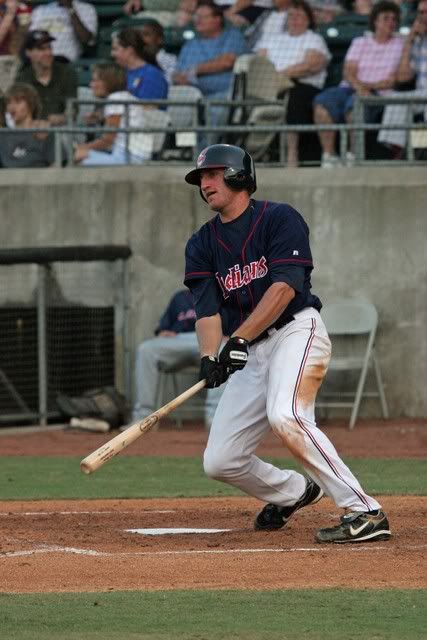 History: Whitney was taken in the first round of the 2002 Draft out of high school, and was a supplemental pick at the end of the first round the Indians obtained when Juan Gonzalez (Type-A free agent) was lost in free agency after the 2001 season. Whitney immediately had Indians scouts excited when at 18 years of age he showed exceptional power in rookie level Burlington where he hit .286 with 10 HR and 33 RBI in 45 games. Last year, Whitney was named the starter at first base for the Northern Division team in the South Atlantic League All-Star Game. Also, he finished the 2007 season tied for fourth in home runs (32) among all minor leaguers.
History: Whitney was taken in the first round of the 2002 Draft out of high school, and was a supplemental pick at the end of the first round the Indians obtained when Juan Gonzalez (Type-A free agent) was lost in free agency after the 2001 season. Whitney immediately had Indians scouts excited when at 18 years of age he showed exceptional power in rookie level Burlington where he hit .286 with 10 HR and 33 RBI in 45 games. Last year, Whitney was named the starter at first base for the Northern Division team in the South Atlantic League All-Star Game. Also, he finished the 2007 season tied for fourth in home runs (32) among all minor leaguers.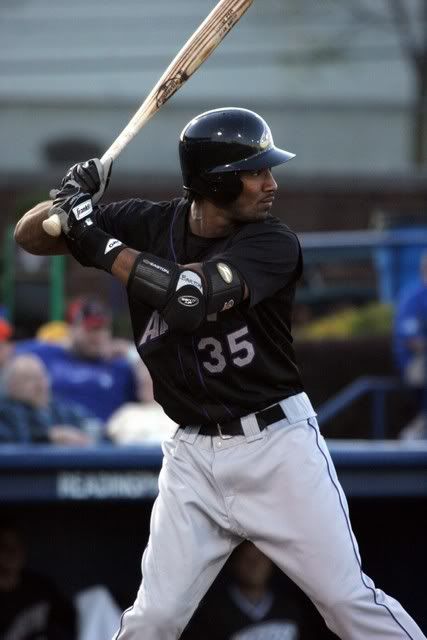 History:
History: History: Lofgren was projected to go much higher in the 2004 Draft, but fell due to signability concerns, and the Indians eventually selected him in the 4th round out of Junipero Serra High School (CA). He graduated from the same high school as Barry Bonds, Tom Brady, Lynn Swann and Greg Jeffries. Lofgren's 2006 season at Kinston was sensational, as he went 17-5 with a 2.32 ERA, held opponents to a .217 batting average against (BAA), and piled up 125 strikeouts in 139.2 IP. Lofgren set a Kinston modern-day franchise record for victories by a pitcher in a season with 17, and his 17 wins tied him for the most wins in all of the minors that season. He was also named the Carolina League Pitcher of the Year. In a May start on Mother's Day last year, Lofgren threw seven no-hit innings before leaving because of a high pitch count.
History: Lofgren was projected to go much higher in the 2004 Draft, but fell due to signability concerns, and the Indians eventually selected him in the 4th round out of Junipero Serra High School (CA). He graduated from the same high school as Barry Bonds, Tom Brady, Lynn Swann and Greg Jeffries. Lofgren's 2006 season at Kinston was sensational, as he went 17-5 with a 2.32 ERA, held opponents to a .217 batting average against (BAA), and piled up 125 strikeouts in 139.2 IP. Lofgren set a Kinston modern-day franchise record for victories by a pitcher in a season with 17, and his 17 wins tied him for the most wins in all of the minors that season. He was also named the Carolina League Pitcher of the Year. In a May start on Mother's Day last year, Lofgren threw seven no-hit innings before leaving because of a high pitch count. History: Lewis was picked in the 3rd round of the 2005 Draft out of Vanderbilt University. Lewis was a mid-season NY-Penn League All Star in 2005 while at short-season Single-A Mahoning Valley, and in 13 appearances (11 starts) Lewis was 4-2 with a 3.20 ERA and in 59 innings pitched allowed 58 hits, 11 walks and struck out 59. Still a starter in 2006, Lewis went 8-8 with a 3.96 ERA in 27 combined starts in Kinston and Akron. As a reliever last year, when he was promoted from Akron to Buffalo he gave up a solo home run to the first batter he faced and after that only allowed one run. From May 1st until he was called up to Cleveland on July 13th he had a 0.68 ERA.
History: Lewis was picked in the 3rd round of the 2005 Draft out of Vanderbilt University. Lewis was a mid-season NY-Penn League All Star in 2005 while at short-season Single-A Mahoning Valley, and in 13 appearances (11 starts) Lewis was 4-2 with a 3.20 ERA and in 59 innings pitched allowed 58 hits, 11 walks and struck out 59. Still a starter in 2006, Lewis went 8-8 with a 3.96 ERA in 27 combined starts in Kinston and Akron. As a reliever last year, when he was promoted from Akron to Buffalo he gave up a solo home run to the first batter he faced and after that only allowed one run. From May 1st until he was called up to Cleveland on July 13th he had a 0.68 ERA. History: Hodges was drafted in the 2nd round of the 2006 Draft out of Georgia Tech, but did not play in 2006 with the Indians since he was still mending from a stress fracture in his foot. Even though he basically played on one leg more almost all of his final season at Georgia Tech, Hodges still hit .329 with 11 HR and 68 RBI in 219 at bats. Last year, Baseball America tabbed Hodges as the best power prospect, the best defensive third baseman, and having the best tools in the Carolina League. He was also named Team MVP at Kinston, and was a Carolina League Post-Season All Star.
History: Hodges was drafted in the 2nd round of the 2006 Draft out of Georgia Tech, but did not play in 2006 with the Indians since he was still mending from a stress fracture in his foot. Even though he basically played on one leg more almost all of his final season at Georgia Tech, Hodges still hit .329 with 11 HR and 68 RBI in 219 at bats. Last year, Baseball America tabbed Hodges as the best power prospect, the best defensive third baseman, and having the best tools in the Carolina League. He was also named Team MVP at Kinston, and was a Carolina League Post-Season All Star. History: Before last season, Brown got a lot less pub than his former University of Arizona Wildcat teammate Trevor Crowe. While Crowe was drafted in the 1st round of the 2005 Draft, Brown was selected a few rounds later in the 4th round of the same draft. After a very slow start in 2006 where he hit .232 with 0 HR and 9 RBI in Kinston's first 28 games that season, Brown settled in to finish the season hitting .290 with 15 HR, 87 RBI and an .831 OPS and won the Carolina League MVP Award in 2006, and his career has taken off from there. Last year at Akron, his .333 batting average won him a league batting title, and he also finished 1st in the league in hits (161), 6th in runs (85), 4th in doubles (36), 9th in RBI (76), 3rd in on-base percentage (.421), 11th in slugging percentage (.484), and 5th in OPS (.906).
History: Before last season, Brown got a lot less pub than his former University of Arizona Wildcat teammate Trevor Crowe. While Crowe was drafted in the 1st round of the 2005 Draft, Brown was selected a few rounds later in the 4th round of the same draft. After a very slow start in 2006 where he hit .232 with 0 HR and 9 RBI in Kinston's first 28 games that season, Brown settled in to finish the season hitting .290 with 15 HR, 87 RBI and an .831 OPS and won the Carolina League MVP Award in 2006, and his career has taken off from there. Last year at Akron, his .333 batting average won him a league batting title, and he also finished 1st in the league in hits (161), 6th in runs (85), 4th in doubles (36), 9th in RBI (76), 3rd in on-base percentage (.421), 11th in slugging percentage (.484), and 5th in OPS (.906). History: Miller was drafted out of high school (TX) in the 1st round of the 2003 Draft, and had a commitment to play for the University of Arizona before signing with the Indians. Miller was unbelievable the final two months of the 2006 season at Akron as he posted a 0.29 ERA in July and a 1.59 ERA in August, and then followed that up in spring training last year by pitching 14 scoreless innings in five games. Miller's 15 wins at Akron in 2006 set a franchise record, passing Paul Byrd's 1992 franchise record of 14 wins in a season. His 161 strikeouts also crushed the single-season team record of 149, which was set by Travis Driskill in 1996. He was named the Eastern League Pitcher of the Year in 2006, and was also the Indians Minor League Pitcher of the Year (Bob Feller Award) in 2004 and 2006.
History: Miller was drafted out of high school (TX) in the 1st round of the 2003 Draft, and had a commitment to play for the University of Arizona before signing with the Indians. Miller was unbelievable the final two months of the 2006 season at Akron as he posted a 0.29 ERA in July and a 1.59 ERA in August, and then followed that up in spring training last year by pitching 14 scoreless innings in five games. Miller's 15 wins at Akron in 2006 set a franchise record, passing Paul Byrd's 1992 franchise record of 14 wins in a season. His 161 strikeouts also crushed the single-season team record of 149, which was set by Travis Driskill in 1996. He was named the Eastern League Pitcher of the Year in 2006, and was also the Indians Minor League Pitcher of the Year (Bob Feller Award) in 2004 and 2006.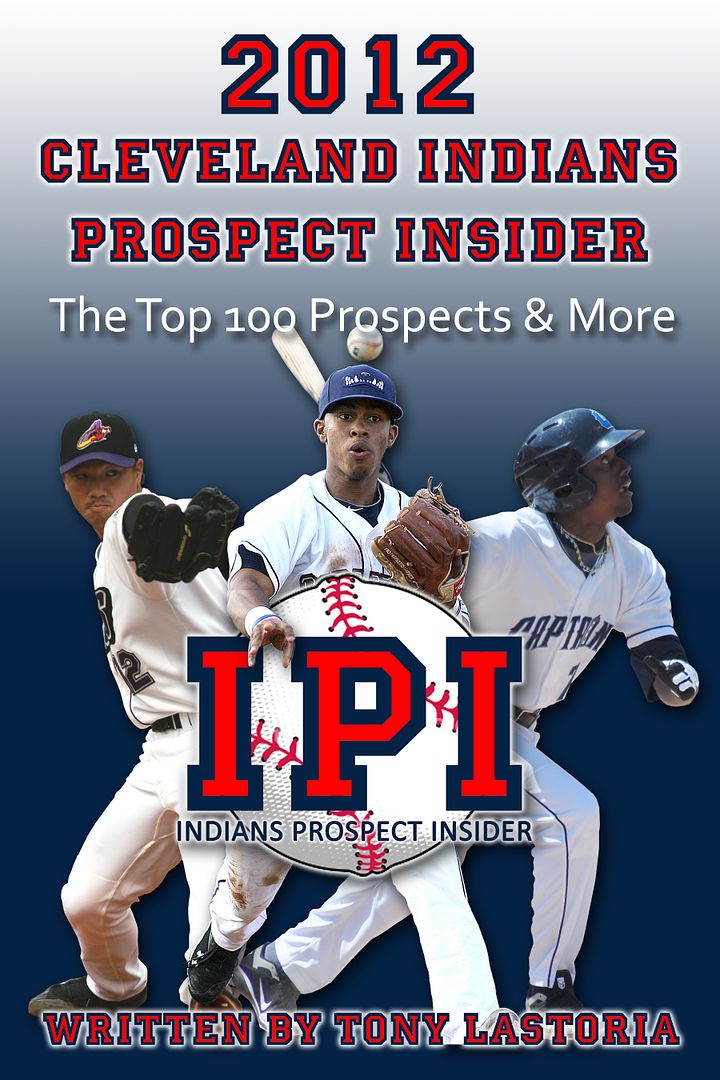
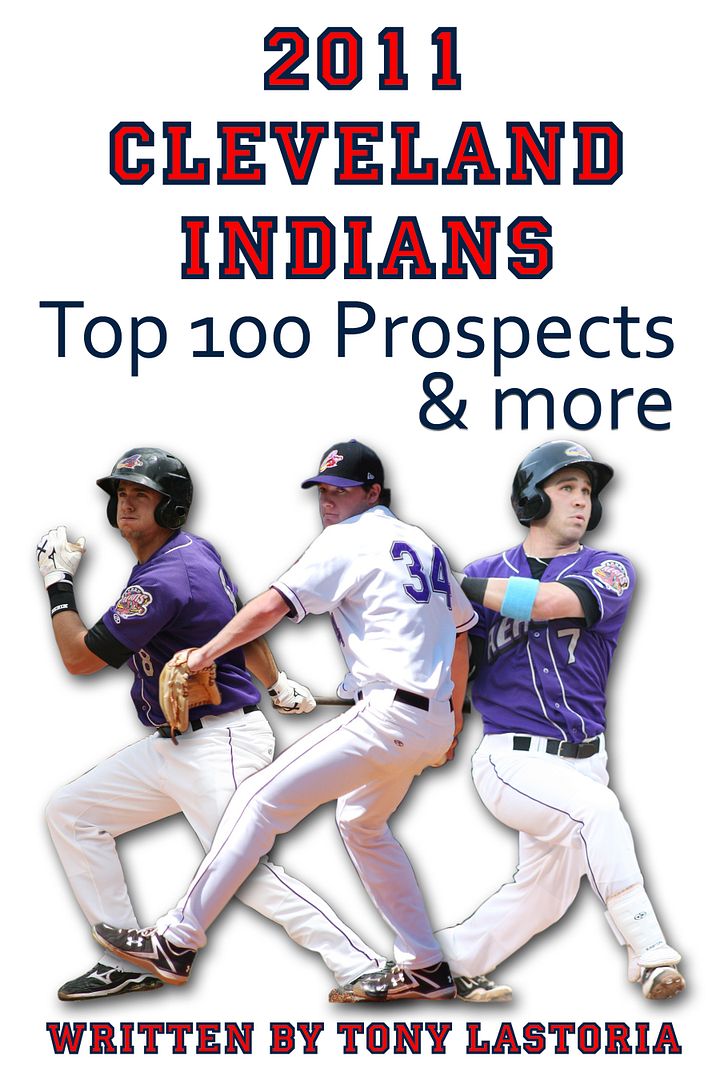
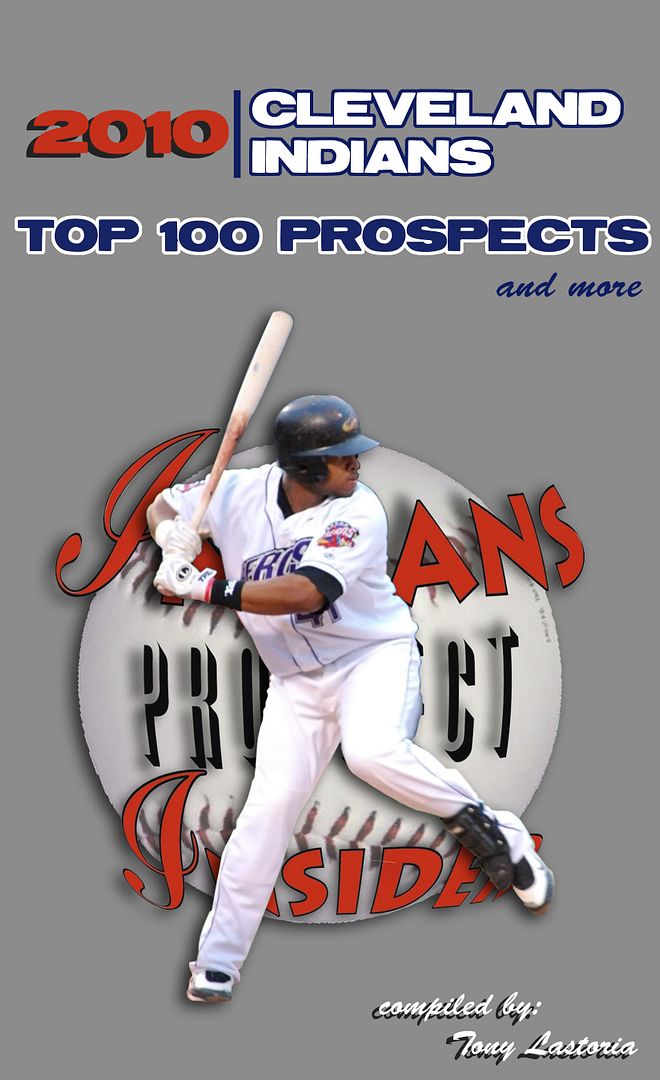
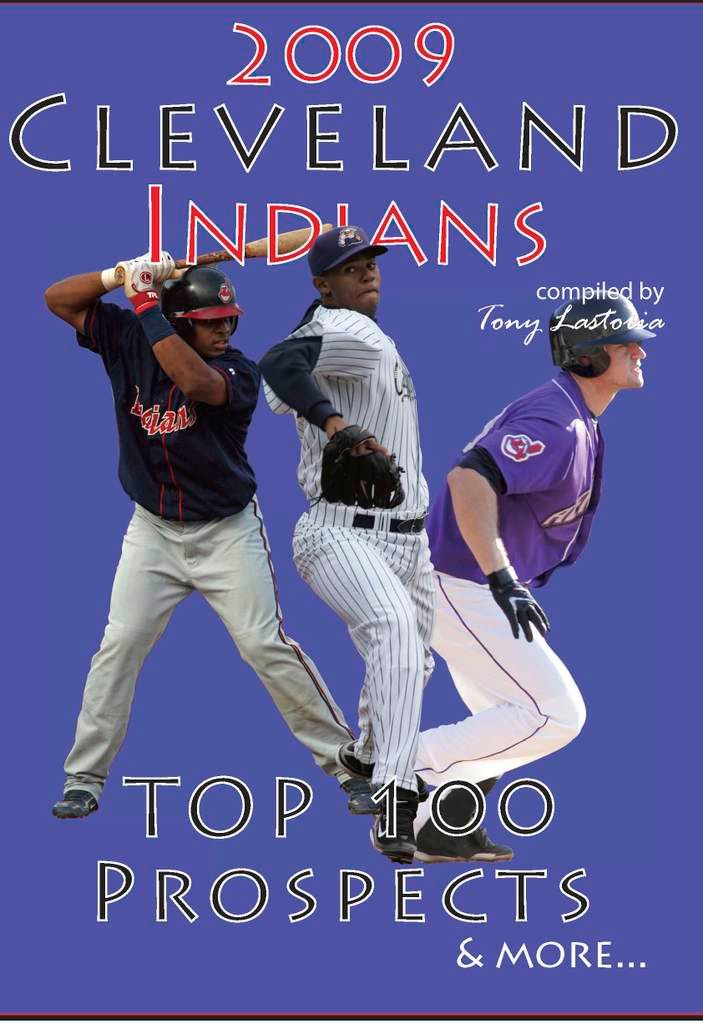
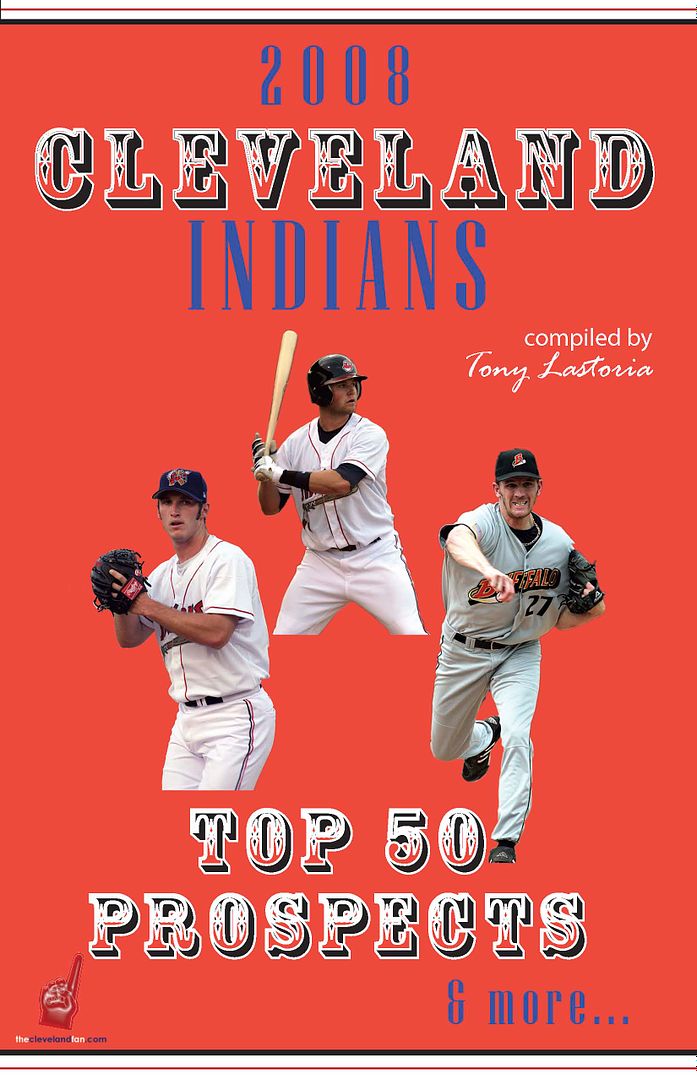
 Everything on this site is free, but for those interested in making any monetary contributions to help support the stability and growth of this site please click on the "Donate" button below.
Everything on this site is free, but for those interested in making any monetary contributions to help support the stability and growth of this site please click on the "Donate" button below.

